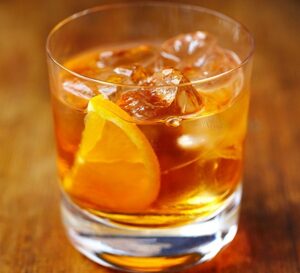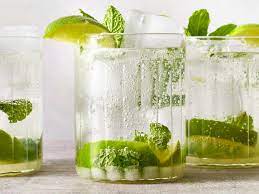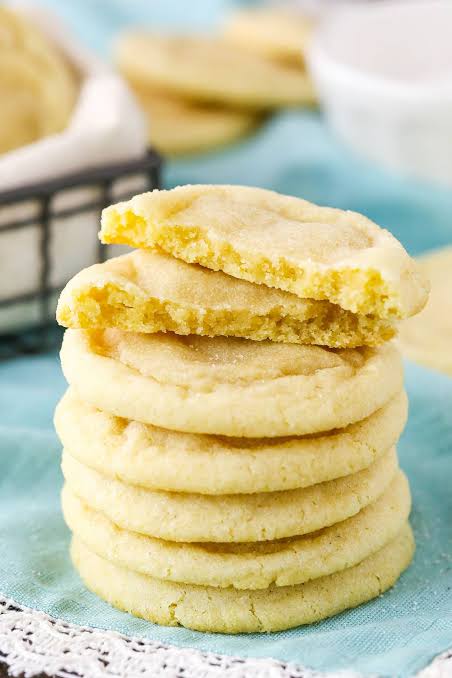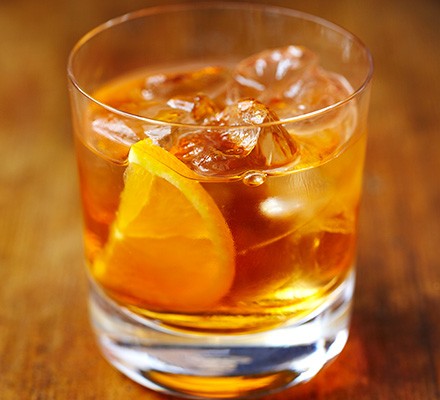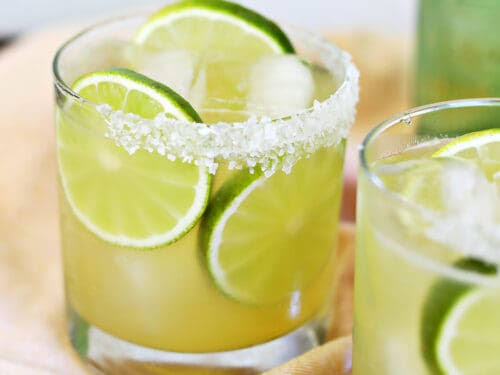
About margarita:-
A margarita is a popular cocktail that originated in Mexico, known for its refreshing and tangy flavor profile. It is typically made with tequila, lime juice, and an orange liqueur like Cointreau or Triple Sec, and is often served in a glass with a salted rim. Margaritas can be enjoyed on the rocks (poured over ice), blended (as a frozen drink), or straight up (shaken with ice and strained).
Margarita Recipe
Ingredients (for 1 serving):
- Tequila: 50ml
- Lime juice: 25ml (freshly squeezed)
- Cointreau or Triple Sec: 20ml (or another orange liqueur)
- Simple syrup (optional): 10ml (for a sweeter drink)
- Ice: A handful for shaking and serving
- Salt: For rimming the glass
- Lime wedge: For garnish
Steps:
1. Prepare the Glass:
- Take a rocks glass (short tumbler) or a margarita glass (which has a wider, rounder rim).
- Rub the lime wedge around the rim of the glass to moisten it.
- Dip the rim into coarse salt, rotating it gently to coat the edge evenly. You can use kosher or sea salt for a traditional touch.
2. Squeeze Fresh Lime Juice:
- Use fresh lime juice, as it dramatically improves the taste of the margarita compared to bottled juice.
- You’ll need about 1 medium lime to get 25ml of juice.
3. Measure and Pour Ingredients:
- In a cocktail shaker, combine:
- 50ml of tequila
- 25ml of fresh lime juice
- 20ml of Cointreau or Triple Sec
- Optional: 10ml of simple syrup if you prefer a sweeter margarita.
4. Add Ice and Shake:
- Fill the cocktail shaker with ice.
- Secure the lid and shake vigorously for about 15-20 seconds. Shaking helps chill the drink quickly and dilutes it slightly to balance the flavors.
5. Strain and Serve:
- Fill the prepared glass with fresh ice.
- Strain the margarita mixture into the glass.
- Garnish with a lime wedge on the rim or place it in the drink.
Key Elements of a Perfect Margarita
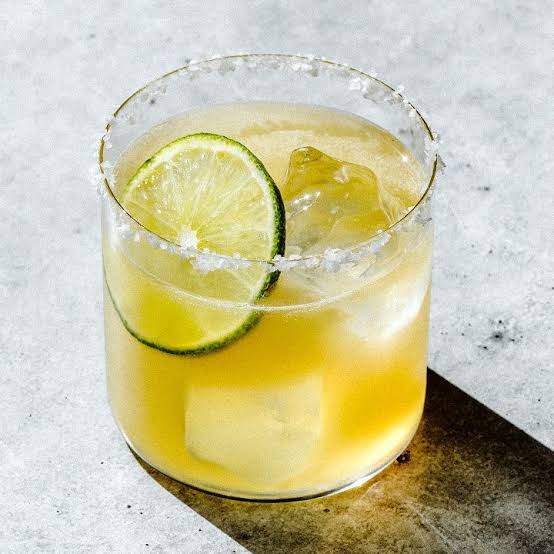
1. Tequila:
- Tequila is the heart of any margarita, and its quality determines much of the drink’s flavor.
- Use 100% blue agave tequila for the best taste. Cheaper tequilas may be “mixto,” meaning they’re only partially made from agave and mixed with other sugars, which can lead to a harsher taste.
- There are three main types of tequila:
- Blanco (white): Unaged or aged for less than two months, this type has a clean, crisp taste and is often used in margaritas for its bright flavor.
- Reposado: Aged in oak barrels for 2-12 months, reposado tequilas have a more complex, slightly oaky flavor.
- Añejo: Aged for more than a year, añejo tequilas are rich and deep, with a smoother taste, but are less common in margaritas as their nuances may be overshadowed by the lime and orange liqueur.
2. Lime Juice:
- Fresh lime juice is non-negotiable for a proper margarita. Bottled lime juice lacks the fresh, vibrant acidity needed to balance the drink.
- The citrus flavor should be tart and zesty, with a natural sweetness.
- You can roll the lime on the counter before cutting it to release more juice.
3. Orange Liqueur:
- Cointreau, Triple Sec, or other orange liqueurs are used to provide a sweet, citrusy counterpoint to the lime juice.
- Cointreau is more refined, while Triple Sec is a less expensive but still effective alternative.
- You can adjust the amount of orange liqueur depending on how sweet or dry you prefer your margarita.
4. Sweetener (Optional):
- Traditional margaritas may not always include sweetener, but many modern recipes use simple syrup or agave nectar to soften the acidity of the lime juice.
- To make simple syrup, dissolve equal parts sugar and water by heating until the sugar dissolves completely.
- Agave nectar is another excellent sweetener, especially as it complements the agave in tequila.
5. Ice:
- Ice is crucial for both shaking and serving. It helps dilute the drink slightly, balancing the strong flavors of tequila and lime juice.
- When shaking, the ice should be plentiful enough to chill the drink quickly.
- For serving, use fresh, cold ice to avoid watering down the drink too quickly.
6. Salt:
- The salted rim adds a savory contrast to the tart and sweet flavors of the margarita. Kosher salt or sea salt is best for rimming the glass as it’s less processed than table salt.
- For an extra kick, mix a small amount of chili powder with the salt to give the drink a spicy twist.
Margarita Variations
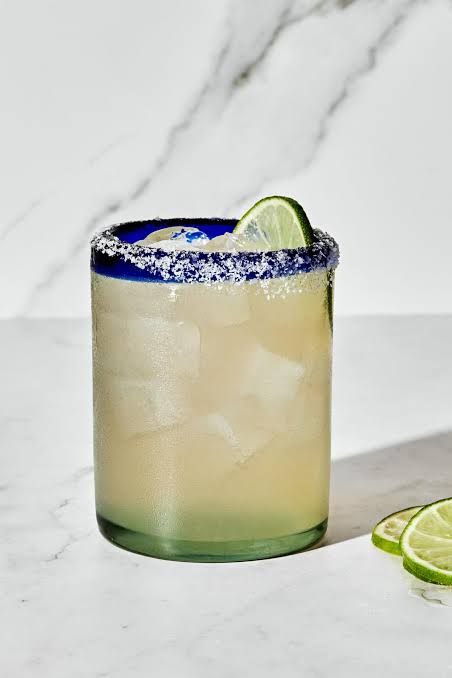
1. Frozen Margarita:
- For a frosty treat, blend the ingredients with crushed ice instead of shaking.
- Combine 50ml tequila, 25ml lime juice, 20ml Cointreau, and 10ml simple syrup with 1 cup of ice in a blender. Blend until smooth.
- Serve in a salted glass and garnish with a lime wedge.
2. Spicy Margarita:
- Add some heat by muddling jalapeño slices or using spicy tequila (infused with chili peppers).
- Shake the jalapeño slices with the other ingredients or simply rim the glass with chili salt.
3. Fruit Margarita:
- You can add fruit purees for a fruity twist. Common variations include:
- Strawberry Margarita: Blend or muddle fresh strawberries with the tequila and lime juice.
- Mango Margarita: Use fresh or frozen mango chunks to create a sweet, tropical flavor.
- Pineapple Margarita: Muddle or blend pineapple for a fresh, tropical vibe.
4. Mezcal Margarita:
- For a smokier flavor, substitute some or all of the tequila with mezcal. Mezcal has an earthy, smoky taste that adds complexity to the drink.
5. Skinny Margarita:
- For a lighter version, omit the simple syrup and reduce the amount of orange liqueur. The drink will rely solely on the natural sweetness of the liqueur and lime juice.
6. Margarita Pitcher Recipe:
- To make margaritas for a crowd, simply multiply the ingredients by the number of servings. Here’s a basic recipe for a pitcher serving 6-8 people:
- Tequila: 300ml
- Lime juice: 150ml
- Cointreau or Triple Sec: 120ml
- Simple syrup (optional): 50ml
- Mix all ingredients in a pitcher and chill in the fridge. When ready to serve, stir and pour over ice in salted glasses.
Tips and Techniques
1. Balancing Flavors:
- A margarita is all about balance—getting the right mix of tartness (lime juice), sweetness (orange liqueur or sweetener), and the strength of the tequila.
- Adjust the ingredients to your taste preferences. For a tarter drink, increase the lime juice. For more sweetness, add a little more orange liqueur or simple syrup.
2. Shaking Properly:
- Shaking the margarita serves two purposes: chilling and aerating the drink. Shake vigorously for at least 15 seconds to blend the flavors properly.
- Make sure to use plenty of ice in the shaker to ensure the drink cools quickly without diluting too much.
3. Garnishing:
- Garnishing isn’t just about looks; the lime wedge or slice can add a final burst of citrus when squeezed into the drink.
- For a twist, you can use other garnishes like orange slices, citrus zest, or even herbs like mint or cilantro for added flavor.
4. Choosing the Right Glass:
- While traditional margarita glasses are iconic, you can also serve margaritas in rocks glasses or coupe glasses. The choice depends on whether you prefer a larger or more compact presentation.
5. Enhancing the Salt Rim:
- Experiment with different types of salt, such as flavored salts (e.g., smoked salt or chili salt) or mix the salt with lime zest or spices to enhance the drink’s flavor profile.
History and Origin of Margaritas
While the exact origin of the margarita is unclear, most stories trace it back to Mexico in the early to mid-20th century. It is thought to be an adaptation of the Daisy cocktail (which also includes a spirit, citrus, and sweetener) but made with tequila instead of brandy. The word “margarita” is Spanish for daisy, linking it to the original cocktail.
Tequila was becoming popular in the United States around the time Prohibition ended, and the margarita
Nutrition Facts (per serving):
- Calories: ~200-250 kcal
- Carbohydrates: ~10-15 grams
- Sugar: ~8-10 grams
- Fat: 0 grams
- Protein: 0 grams
- Sodium: ~500 mg (due to the salted rim)
- Alcohol: ~15-20 grams of alcohol (depends on the amount of tequila)
Key Nutritional Points:
- Alcohol Content:
- The primary contributor to calories in a margarita is the tequila. Each gram of alcohol provides 7 calories, so a margarita can range between 150-200 calories from alcohol alone.
- Tequila contains no carbs, fat, or protein, but it does add calories.
- Carbohydrates and Sugars:
- The Cointreau or Triple Sec (orange liqueur) and lime juice contribute to the sugar and carbohydrate content.
- A classic margarita typically has 10-15 grams of carbs, mostly from sugars in the liqueur and any added sweeteners like simple syrup or agave nectar.
- Sodium:
- If you rim the glass with salt, the sodium content can be quite high—around 500 mg or more depending on how much salt is used. This adds flavor, but it’s something to watch if you’re limiting sodium intake.
- Vitamins and Minerals:
- Fresh lime juice offers a small amount of vitamin C. A margarita can provide about 10-15% of your daily recommended intake of vitamin C due to the lime juice, depending on how much is used.
Health Considerations:
- Calorie-dense: Margaritas are relatively high in calories for a small drink, primarily due to the alcohol content. If you’re watching your calorie intake, limit how many you drink or opt for a “skinny margarita” (less sugar).
- Sugar content: The sugar in margaritas comes from the orange liqueur and any added sweeteners. This can contribute to blood sugar spikes if consumed in excess, especially if you add extra sweeteners like simple syrup.
- Dehydration: Alcohol is a diuretic, meaning it can cause dehydration. Pairing margaritas with water helps mitigate this effect.
Healthier Alternatives:
- To make a healthier margarita, you can:
- Reduce or omit the simple syrup or agave nectar.
- Use low-calorie or sugar-free orange liqueurs.
- Use fresh lime juice without added sugars.
- Skip the salted rim to reduce sodium intake.
What is a margarita?
A margarita is a classic cocktail made with tequila, lime juice, and orange liqueur (such as Cointreau or Triple Sec). It is typically served with a salted rim and can be enjoyed on the rocks (over ice), shaken, or blended with ice (frozen).
What type of tequila should I use for a margarita?
The best margaritas are made with 100% blue agave tequila. You can choose between:
Blanco (Silver): A clean, bright flavor, often used in traditional margaritas.
Reposado: Aged in barrels for a smoother, slightly oaky taste.
Añejo: Aged even longer, with a richer, more complex flavor (though not as common for margaritas).
What’s the difference between Triple Sec and Cointreau?
Both are types of orange liqueur used in margaritas:
Triple Sec: A more affordable, slightly less refined orange liqueur.
Cointreau: A premium version of orange liqueur, smoother and more balanced. It tends to have a higher alcohol content and a more intense flavor.
